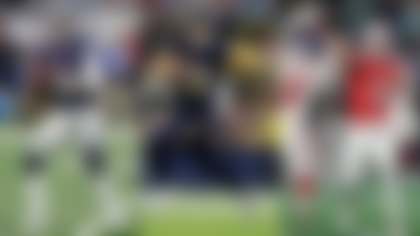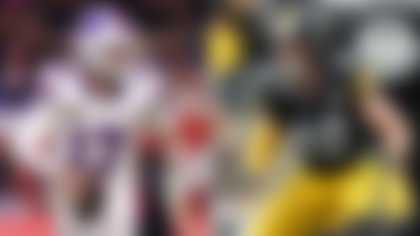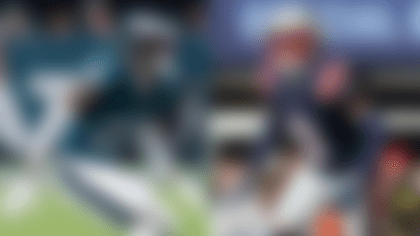Which teams got it right on their critical calls in Week 3 of the 2021 NFL season? Which teams got it wrong? The Next Gen Stats analytics team uses the Next Gen Stats Decision Guide powered by AWS to break down the numbers behind the decisions that shaped the game, focusing on fourth-down and 2-point conversion strategy:


Kyle Shanahan goes against the Guide
The 49ers offense faced four fourth-down situations in their Sunday Night Football home loss to the Packers -- and Shanahan and Co. made the suboptimal decision to punt in all four instances, based on the Next Gen Stats Decision Guide. When you add it all up, the 49ers lost a combined 11.9 percentage points in expected win probability as a result of the decisions.
SECOND QUARTER: With 5:01 remaining and the 49ers (trailing 10-0) facing a fourth-and-1 from the Packers' 49-yard line, Shanahan elects to take a delay of game penalty to set up a punt.
No decision to punt was more costly -- in terms of win probability -- than this one, with San Francisco losing 5.8 percentage points in win probability, when you take into account the odds of converting on fourth-and-1 (78 percent) and the Niners' chances of winning the game based on each outcome (28 percent if they went for it versus 23 percent if punting).
Aaron Rodgers and the Packers responded with an 87-yard scoring drive, giving Green Bay a 17-point lead with just over a minute left in the first half. If not for Trenton Cannon's 68-yard kick return, the 49ers may never have had a chance to get back into this one. In a game decided by two points, making the right calls on fourth down can make all the difference.
Matt LaFleur leaves the door open for the Niners
FOURTH QUARTER: With 2:43 remaining and the Packers (winning 24-21) facing a fourth-and-4 from the 49ers' 20-yard line, Mason Crosby attempts and makes a 38-yard field goal.
At the time of the decision, the Packers had an 84 percent chance to win the game. If they'd gone for a first and converted, their win probability would have jumped to 92 percent -- and it would have soared even higher if the red-zone trip had resulted in a touchdown. Going up two possessions with under three minutes to go would have virtually ended the game.
Instead, LaFleur sent Crosby and the kicking unit out for a 38-yard try. But the best-case scenario there -- Crosby making the kick -- still didn't push the Packers' lead beyond a one-score margin. According to the NGS Decision Guide, LaFleur's decision to kick a field goal instead of going for it cost the team 4.7 percentage points in expected win probability.
In a situation somewhat reminiscent of the 2020 NFC title match, LaFleur opted for three points instead of keeping Rodgers and the offense on the field with a chance to win or tie -- and it almost cost the Packers the game. The 49ers followed with a scoring drive capped by a 12-yard touchdown connection between Jimmy Garoppolo and Kyle Juszczyk, taking a one-point lead with 37 seconds left on the game clock. Fortunately for the Packers, it was just enough time for Rodgers and Davante Adams to connect twice and set up a game-winning field goal by Crosby.


Chargers win despite questionable late-game management
Head coach Brandon Staley was featured in a positive light in our Week 2 decisions piece for his QB-sneak call from his own territory. This week, however, two questionable decisions nearly cost the Chargers their game against the Chiefs.
FOURTH QUARTER: With 2:17 remaining and the Chargers (trailing 24-21) facing a fourth-and-goal from the Chiefs' 6-yard line, Los Angeles's Tristan Vizcaino attempts and makes a 24-yard field goal.
In a game that had already seen three second-half lead changes, Staley played for the tie instead of the win. According to the NGS Decision Guide, the Chargers gave up 3 percentage points in expected win probability value by kicking the field goal to knot the score rather than going for it to take the lead. The main driver of the model's recommendation: Don't give the ball back to Patrick Mahomes with an opportunity to win the game with any score.
It certainly would have been riskier to go for it on fourth-and-goal -- the odds of converting from the Chiefs' 6-yard line sat at 39 percent, while the odds of making a 24-yard field goal were 97 percent. But when the ball sailed through the uprights, L.A.'s win probability actually dropped, according to our model, from 44 percent to 35 percent. Again, don't give the ball back to Mahomes.
FOURTH QUARTER: With 0:36 remaining and the Chargers (tied 24-24) facing a first-and-goal from the Chiefs' 4-yard line, Los Angeles' Justin Herbert finds Mike Williams in the end zone for the go-ahead touchdown.
Scoring a touchdown is rarely suboptimal, but this was one of those moments. Let's break down the numbers:
Assuming the Chargers would have been able to run the clock down to the final seconds to set up a 22-yard game-winning field goal, the odds of Los Angeles winning were the odds of making the field goal: 98 percent. When the Chargers scored a touchdown, the team's chance of winning was only 96 percent. As mentioned above, it is not wise to give Mahomes the ball with the opportunity to win the game with a score, let alone when he has one timeout still to work with. While these numbers are at the margins, and the Chargers ended up winning, the outcome could have played out differently, such that taking a few kneeldowns and setting up a high-probability field-goal try was the better choice.


Jon Gruden makes right call on failed fourth-and-inches run
FIRST QUARTER: With 4:55 remaining and the Raiders (trailing 7-0) facing a fourth-and-1 from their own 34-yard line, Peyton Barber is stuffed for no gain, and the Raiders turn the ball over on downs.
When an offense faces a fourth-and-inches situation, it is more than likely that the numbers will recommend going for it. And that's exactly what Gruden did from his own territory late in the first quarter against the Dolphins, needing 0.8 yards for the first. In the past, many teams may have opted to punt in that situation. Yes, Barber failed to pick up the necessary yardage -- but we're more about process than results when evaluating fourth-down decision-making. Going for it on fourth-and-less-than-1 was the optimal call by 4.3 percentage points in expected win probability, driven by Las Vegas' 75 percent odds of converting on the play.
Gruden's fourth-down decision is representative of coaches across the league embracing the philosophy that football is a game of inches. Using ball-tracking data from Next Gen Stats' RFID chips to measure actual yards to go with decimal precision, we know NFL teams have gone for it 17 out of 20 times (85 percent) with less than 1 yard to go this season. That percentage has increased every season since 2016. Five seasons ago, just 57 percent of teams went for it in less-than-1-yard-to-go situations.
Follow the Next Gen Stats team on Twitter.












